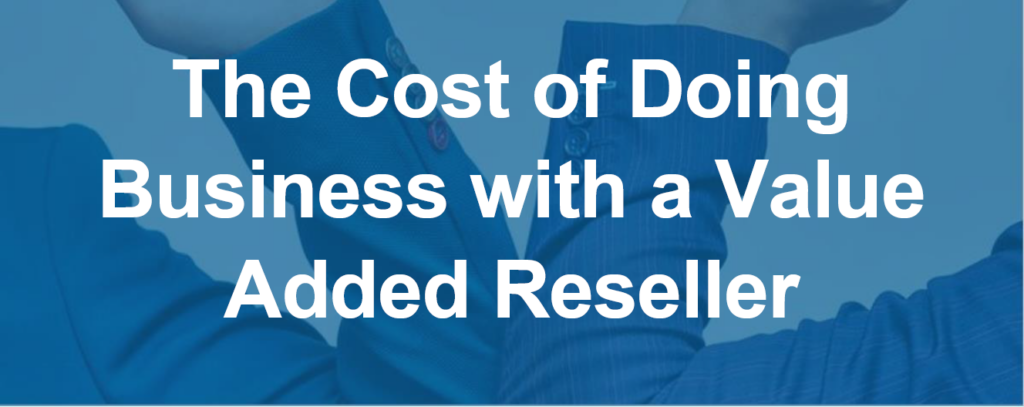
In this article, we’ll discuss the consulting side of a VAR’s work. Oftentimes, we hear clients tell us that they use a particular VAR based on their relationship with the VAR, or the “free” services or advice they get from their VAR. Clients are very often surprised that there is a very real, hard cost associated with doing business with a VAR that is generally never discussed. These costs never enter into a license agreement or a PO for a hardware purchase. In the end, the Client has no way to measure the true cost of doing business with a VAR.
Where do these costs come from and how do I find out how much I am spending on them? Can I avoid the cost? Let’s explore these questions.
VARs or “Value-Added Resellers” are companies designed to take other companies or manufacturers products and add features or services and then resell the product to the end client or user. These additional features can be product-specific consulting or helping the client find the product or service that most closely aligns with the client’s technical specification or need. It may also be an actual integration of a company’s product or service with the manufacturer’s product to create a completely different product or service.
Where does the cost come from? When you pick up the phone and call your friendly VAR to let them know you are about to expand your data center and you need some additional switches and routers, your VAR will generally ask you a few questions about your needs and then let you know they will come back to you with a recommendation on what you need to purchase and the price. They may already know you have a Cisco environment, so they are likely to take that into consideration rather than suggesting another type of hardware. The helpful part of this relationship is that the VAR knows your environment and what you’ve purchased before, so the consulting is fairly easy.
Even if your VAR does not know your situation, and they have to do some research before making a recommendation, the recommendation is generally limited to the amount of time and energy a salesperson would make if they wanted to sell you any good or service.
But here’s the secret…the VAR is paid by the OEM or manufacturer of the hardware that the VAR recommends to you. Yes, all of that “free” consulting is really not free. The VAR is marking up the quote they get from the OEM (sometimes much more considerably than you might think) and you are paying for that consulting based on the margin. Additionally, not all OEMs quote the VARs the same price for the identical item. So, you may be working with a VAR that is getting a great deal and marking the product up as much as needed to hit their revenue targets or a VAR that isn’t getting a great deal and either marks the product up slightly to try to win business or marks the product up enough to make its revenue target. Either way, you are paying this cost.
The rub is…there is generally no way for you to know exactly how much markup you are paying for the hardware from the VAR, or in other words, how much you are paying for your “free” consulting. On average, AIQ sees anywhere from 10% to as high as 40% or more in markup on equipment from the OEM. What is even more challenging than the markup is what is known as the “reservation”.
The moment you contact your VAR for a recommendation or a price on a piece of hardware or software, you’re committed. You are locked into the VAR to make the purchase. When the VAR goes to the OEM’s system to get a price quote and they enter the request, they also enter your company information. Once that is done, the “reservation” is made. If you were to try to price compare by asking another VAR to quote you a price for the same hardware or software, the moment the other VAR attempts to enter the request for your company, it will lock them out of the OEM’s system, due to the reservation from the original OEM.
This article is not to say that VARs shouldn’t make money, of course they should. What is important is to be able to understand your options, how you can gain back some flexibility, and how you can reduce your cost in the process. Here are a few ideas:
- Work directly with the OEMs. If you know what you want to buy, contact the OEM first for a price. Oftentimes they won’t sell you the hardware directly, but they can give you a baseline understanding of cost so when you go to the VAR, you have an idea of what to expect.
- Do your own research. If you are wondering what to buy, try doing your own research. There are many reviews and informational sites that can help. Ask other IT professionals about their experiences with a product or software. You’d be surprised how much you can learn just reviewing published data and hitting up your LinkedIn contacts.
- Never ask for more than a price on 1 piece. If you do need to enlist the help of a VAR in order to figure out what to buy, only get a quote for 1 piece. This will avoid the VAR’s ability to reserve a large order and lock you into purchasing from them.
Instead of working through a VAR, consider contacting AIQ. We can quickly and efficiently assist you in reverse auctioning your purchase and obtaining the very best price the market has to offer. AIQ will help you expand your awareness of suppliers and alternatives plus create competition within the channel. This results in an additional 10-40% savings on the same products or services.
